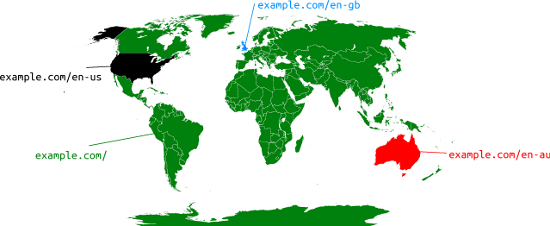“Many websites serve users from around the world with content translated or targeted to users in a certain region. Google uses the rel=”alternate” hreflang=”x” attributes to serve the correct language or regional URL in Search results.”
Questions For Your Marketing & Executive Team:
- Are you planning international expansion for your website and are concerned about SEO?
- Do you have an existing site and have issues with international SEO already?
- Is content not showing up correctly in search results? (Duplicate content issues, targeting issues, display/meta info issues, etc.)
If so, then this will be the most important post you’ll read this year on globalizing your website for users and search engines.
WARNING: Before Starting International SEO
When you plan to “go global” with your website, don’t just translate and publish!
Consider the operational context as well as the softer values: You’ll still need to address cultural, market and audience concerns. And, money management: Are you selling in US dollars only today, but can’t manage international currencies?
That includes getting and providing support from users in the new language. They should help by recommending, linking, reviewing and adding clients or customers to your marketing and sales funnels.
Your international expansion should follow your best practices of business building as you first created it in your core language.
Think business “speak” before “geek”. And yes — that must include traffic research (in your market and your web analytics), core message and (sales) conversion opportunities. Does it even make sense to expand or are you just sitting on a pile of cash and want somewhere to spend it? (Don’t!)
Message, Market & Speed Still Matters
Focus on your message, market match, user experience, page speed and overall search engine friendliness.
For example, for speed concerns, a CDN would be a good option for optimizing user load times in an international context. Check with your hosting partner for options like Cloudflare and MaxCDN. Try to use a local hosting company.
International Site Configuration and Language
The international site structure carries importance.
You must decide on a country or language specific targeting option. You might consider a complete, separate top level domain (.co.uk, .de or .fr) – or a language specific sub-domain or sub-directory. Variations of these can exist in each configuration.
The local language and nuances within it must be considered. The content must be updated regularly so as to not appear stale.
If you need additional support (customer service, sales, etc) – make sure you can relate to their concerns (speak the same language, no pun intended!). Provide a well-trained, competent staff to support this international expansion. Different currencies and exchange rates will play into your back office and sales support as mentioned.
Company Team Support Is Not An After Thought
Internally, you need to set expectations properly. Create or adopt a search first mentality within your global expansion.
Always think about how to stay search friendly and how your content and pages can help users. Let Google know how you have expanded and configured your site. Hreflang is a signal to help search engines figure this out.
Hreflang Syntax for International SEO
This is a signal that was formerly supported by Google in 2011.
You can use the rel=alternate” hreflang = “xx” in an on-page markup, or as a link attribute in the head in the documents, or in the link http header.
As an international SEO agency, our favorite option is to configure these signals inside an XML sitemap, as it covers all alternates for each URL and you can easily submit them to Google via the search console.
For example, the “xx” value can be set to “en” for all English speakers worldwide, or “en-gb” for English speaking in the UK, specifically. (Great Britain)
Hreflang Examples:
English – broad:
<link rel=”alternate” hreflang=”en” href=”https://en.example.com/page.html” />
German – specific:
<link rel=”alternate” hreflang=”de” href=”https://de.example.com/seite.html” />
Here is an example scenario of different English speaking countries and hreflang use for SEO:
The specific hreflang syntax to support the above international website business case study:
Test from different search IP numbers
Even without the hreflang signal, (hreflang checker) Google will try to find the best search results.
It often is not enough, however.
And, you can easily test this: Run different searches on your brand using a VPN after you’ve changed the IP origin. You’ll notice that the results are often not what you expected. Configure the right site structure and use hreflang to help you.
Hreflang In The Operational Context
If you have complex URLs, session ids that create duplicate URLs, make sure to use hreflang to the canonical version of the URLs.
All alternates should be specified on each page whether you use XML sitemaps, https headers or on-page markup.
As a webmaster, you can control these signals, and place the syntax on the same or separate domains, even sub-domains. That includes country specific of generic, top-level TLD’s (top level domains).
The information architecture should be similar to your original site. It will help on support, and also crawling.
TIP: Inside the Google search console you can also target using the geographic targeting feature in the webmaster tools. It’s not specific to all country versions, however. Bing webmaster tools also should be used.
Make sure to add each profile to the search console including separate Google analytics IDs.
Hreflang and The Benefits
The hreflang signal when applied correctly can have big benefits and outcomes for you.
First, it helps search engines consolidate multiple indexing signals, by understanding relationships between your sites, and to more accurately crawl and index pages. This includes discovery of new pages as you expand your site content.
Secondly, users and search engines (Google!) are always striving for relevant, targeted (geo) results. Providing relevant web addresses that show up in their related country specific locales is an obvious win for users, search engines and you.
User experience and user engagement is more important than ever before.
As you either expand sites, or want to add multiple languages, consider check listing your current international SEO efforts as outlined, and use ccTLDs, subdirectories or subdomains in your approach.
Avoid using country specific parameters or session ids as it is the least search friendly option.
Need Assistance With International SEO?
NEED SOME HELP? Contact Us Here and schedule your time.Jon Rognerud and Chaosmap work with Fortune 500 companies, associations and entrepreneurs to create digital traffic strategies that scale up members, customers, leads and sales with profitable returns. Mr. Rognerud wrote a best-selling book (Buy On Amazon), “The Ultimate Guide To Optimizing Your Website” (Entrepreneur). Connect directly here.









